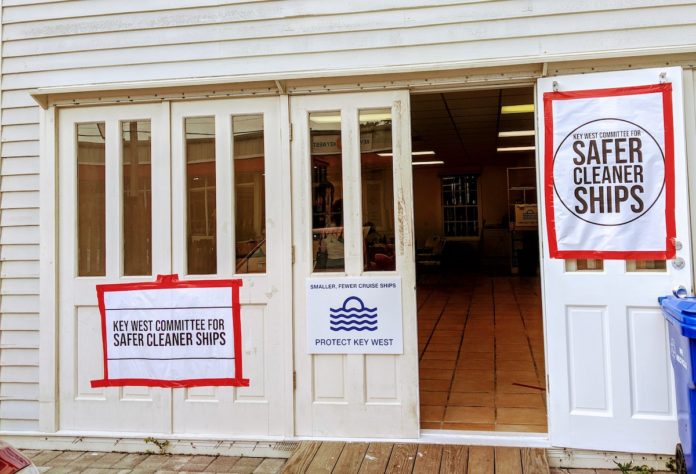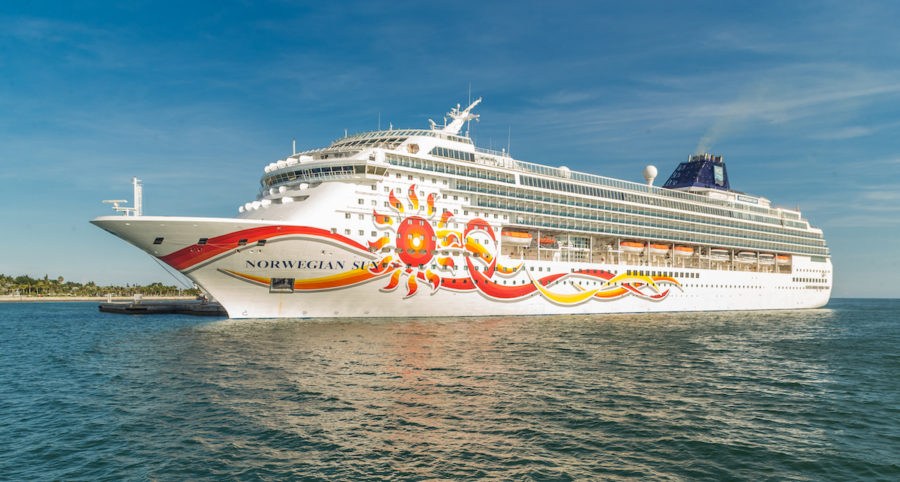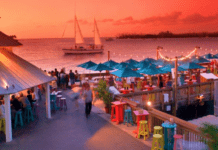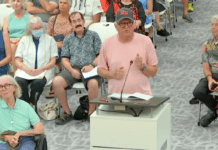
No cruise ships have visited Key West since March, when the effects of the global pandemic reached the United States and, more specifically, the Florida Keys.
The ensuing period of business shutdowns and safer-at-home directives led some people in the Southernmost City to form the Key West Committee for Cleaner, Safer Ships, with a goal to reduce the size and number of ships that are allowed to visit Key West annually.
The issue is a divisive one, pitting business owners and employees who depend on cruise passengers’ spending for their income and livelihoods against others who view the behemoth ships as environmental dangers and economic detractors.
The Committee for Safer Cleaner Ships, led by Evan Haskell and Jolly Benson, in recent months launched a petition drive to obtain the required 1,600 signatures to place a voter referendum, or question, on the August ballot to change the city charter to limit cruise ships. The deadline for signatures is June 1.
The campaign includes three separate petitions that must be signed in person in the committee’s headquarters at 720 B Caroline St.
The argument for fewer, smaller, cleaner ships
The petitions summarize the committee’s three primary goals: Limit the number of cruise passengers who can disembark in Key West to 1,500 per day; prohibit ships with a capacity greater than 1,300 passengers from docking in Key West; and give priority to cruise lines with the best environmental and health records.
The website for Safer Cleaner Ships details a case study of the cruise ship industry and concludes that “cruise ships are a risk to public health; cruise ships threaten the environment and cruise ships put our economy in jeopardy.”
The study, which is labeled a “paid political advertisement by the Committee for Safer Cleaner Ships,” concludes that cruise ships contribute $91,000 per year to the city government coffers, a figure that is disputed by many who support a rational approach to continuing cruise ship visits.
In explanation of the conclusions, the committee states, “Centers for Disease Control (CDC) found cruise ship-linked cases of COVID-19 accounted for 17% of all known cases in the U.S. during February and March. Twelve percent of all COVID-19 cases in Australia came from a single cruise ship, Carnival’s Ruby Princess. Key West now allows more than 390 cruise ships every year, over 10,000 passengers and crew per day, and more than 1.2 million annually,” the website states.
With regard to the environment, the committee states, “Cruise ships are 1% of global shipping, but generate 25% of all waste. Cruise ships create silt clouds around our reef that threaten the survival of juvenile corals. Carnival Cruise Line was fined $40 million and put on probation in 2016 for dumping plastics and oily discharges. They violated probation by falsifying records and were fined an additional $20 million in 2019. More than 130 Carnival ships docked in Key West last year, carrying over 450,000 people.”
As for the economic jeopardy, the committee states, “More than 50% of Americans say they will avoid crowded destinations until the COVID-19 threat is resolved. ‘More’ cruise ships are no longer ‘better’ in Key West. One cruise ship-imported infection can destroy an entire tourist season for Key West, and permanently damage our safe tourism brand.
“Cruise ship passengers make up 50% of all tourists in Key West but only 8% of all tourist spending. Cruise ship passengers spend an average of only $32 in Key West vs. $550 by all other tourists. It takes 17 cruise ship passengers to match the spending of one non-cruise tourist.”
The solution, according to the committee, is fewer, safer and cleaner ships.
“We must balance the limited benefits of cruise ships against larger health, environmental, and economic interests of Key West. The new policy reduces both the capacity of ships and the maximum number of disembarking visitors by approximately 50% per year. These safer, cleaner, smaller ships attract higher-spending customers and have less impact on the marine environment.”

Business owners weigh in
“I truly believe there is still a fighting chance for diplomacy and compromise,” said George Fernandez, who owns the Key West Butterfly & Nature Conservatory on upper Duval Street with business partner Sam Trophia, as well as a gift shop and art gallery in The Shops at Mallory Square, in the downtown epicenter of cruise ship passenger foot traffic.
Fernandez recently presented to the Key West Chamber of Commerce some issues he feels must be addressed “or we are heading in for a serious legal war.”
He also emphasized an eagerness to compromise and to “work together to bring a better quality of life to our Key West community.”
“Over the years we have seen firsthand the crucial impact the cruise industry plays in the economy of the lower Duval Street business community,” Fernandez said. “Between 73% and as much as 95% of our business at this location is specifically cruise ship-driven.
“The cruise ship industry will provide substantial revenue to the City of Key West of over $6 million for their 2020-21 budget fiscal year, according to the Key West Port Authority budget summary,” Fernandez said.
“After every hurricane, the return of the cruise ships has proven to be the first source of revenue to help the trickle-down effect for the struggling community,” he said, adding, “The 2005 Cruise Ship Impact Study showed that passengers spent $28.4 million, crew members $13.1 million, and cruise ship purchases totaled $14 million for a grand total of more than $55.6 million during their annual visits.”
Fernandez recommends the city consider a “feasible three- to five-year, long-term plan that would include a gradual limitation in the number of port calls and passengers.”
“Increasing the number of cruise ship visits/passenger counts has shown that it does not directly equate to a linear economic response,” Fernandez wrote.
That long-term plan could include black-out periods during peak tourism events when no ships would be permitted to visit Key West.
Fernandez also recommends increasing the minimum length of stay for the cruise ships and gradually increasing the disembarkation fees paid by the cruise lines to the city on a per-passenger basis.
“Many passengers on average are only able to spend 3.1 hours on their shore visit, while research showed that an ideal nine-hour ship visit would increase passenger purchases by 50%.
Finally, Fernandez suggests “tighter controls to ensure best management practices are put forward. We must hold all cruise ships accountable as necessary for water quality and their environmental impact by periodically evaluating management actions and validating quantitative models used to closely monitor and fine those culpable with punitive monetary repercussions to be paid to the City of Key West, and suspend their future port visitation status for a period of time.”
Business owner Ed Swift, whose company, Historic Tours of America, operates the Conch Tour Train, Old Town Trolley and several downtown attractions, called the timing of the petition drive “inconsiderate at a time when people are losing their jobs and businesses.”
Swift also questions the legality of some of the committee’s proposals as well as the full economic impact of cruise ship limitations.
“I would hope before they put this on a ballot, someone would check the proposal for legality,” Swift said, adding that the cruise ship passengers’ impact is largely limited to a four-block radius in the downtown area.
“But I will say I believe Key West may be in a better position now to negotiate better agreements with the cruise lines given the decreased desirability of Mexico and the closure of Cuba,” Swift added. “But eliminating the ships entirely seems very short-sighted.”
Scott Saunders’ business, Fury Water Adventures, also depends on cruise ship passengers to fill his snorkel boats and other water excursions.
Saunders declined to comment specifically on the issue at this time, saying he first needs to “better understand the options that are available to us. I think this is just one piece of a larger conversation about what we want our island to be for visitors and residents.”
Elected officials weigh in
Key West city commissioners are fully aware of the emerging cruise ship debate, but not all were prepared this week to comment on the issue.
“I’ve easily gotten more emails and calls about this topic than any other subject since I was elected,” Commissioner Mary Lou Hoover told The Weekly on May 20. “A lot of the emails I’ve gotten are from workers in downtown businesses that depend on cruise ships for their income.”
Hoover observed that Key West’s Duval Street is actually three separate economic zones, for upper, middle and lower Duval, each with individual needs and priorities.
“I’m excited by the fact that we can reimagine tourism,” she said, but said now is not the time to be limiting any sort of revenues coming into the city or its private businesses.
“There are a lot of other things we’re going to have to deal with in the wake of this pandemic — suicide, substance abuse and physical abuse — and I don’t believe that taking people’s livelihoods away should be one of them.”
“Any changes would have to occur over a lengthy period of time to allow business owners to adjust their business plans,” Hoover said.
Commissioner Jimmy Weekley agreed with a gradual implementation of any changes to the city’s cruise ship policies.
“This discussion is long overdue and one we need to have,” Weekley said. “I’ve only heard a few people say, ‘Let’s get rid of cruise ships completely.’ But any changes made need to be done gradually. Perhaps we should, in fact, be marketing to the smaller, more upscale cruise ships, but we need to fully understand the economic impacts of any decisions.”
Weekley said, ”To my knowledge, the city has no control over what ships dock at the privately owned Pier B, which is owned by the Margaritaville Key West Resort & Marina.”
Pier B the only one of the city’s three cruise ship docks that is privately owned. The U.S. Navy owns the Outer Mole and works with the city to share revenue. The city owns the Mallory Square mooring.
“But there’s nothing to stop us from negotiating with the owners of Pier B to see what sort of agreements we can negotiate,” Weekley said.
Mayor Teri Johnston declined to discuss her position on the issue, as it will come before voters.
“Our job is to educate our voting public on both sides of the issue,” Johnston said. “Just like channel widening, the height referendum and every other referendum that has come in front of us as elected officials, we are not allowed to take a side because we represent both sides of the issue, so we are educators.”
Johnston said she is sitting down with both sides of the issue and trying to gather as much data as possible and to understand both sides of the issue.
“Our role is to provide facts so the public can make their own voting decision on this issue,” she said.























